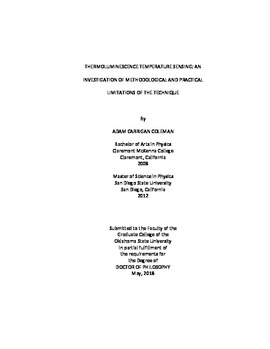| dc.contributor.advisor | Yukihara, Eduardo G. | |
| dc.contributor.author | Coleman, Adam Carrigan | |
| dc.date.accessioned | 2019-03-25T21:59:34Z | |
| dc.date.available | 2019-03-25T21:59:34Z | |
| dc.date.issued | 2018-05 | |
| dc.identifier.uri | https://hdl.handle.net/11244/317775 | |
| dc.description.abstract | Scope and Method of Study: This work had three primary goals. The first was to investigate the validity and accuracy of the initial rise method and the two-dimensional deconvolution method in their application to complex Thermoluminescence (TL) curves. The second goal was to use these methods to obtain the trapping parameters of novel temperature sensing TL materials: Li2B4O7:Cu,Ag (LBO), MgB4O7:Dy,Li (MBO), and CaSO4:Ce,Tb (CSO), and finally to determine the limitations of TL temperature sensing methodology as a diagnostic technique for bio-agent defeat testing. The initial rise method and the two-dimensional deconvolution method were used to reconstruct the trapping center distributions of simulated, realistic, TL curves associated with a variety of trapping center distributions. Trapping center parameter studies were conducted on experimental TL curves for LBO, MBO, and CSO. The limitations of the TL temperature reconstruction technique were studied using numerical simulations and heat transfer methods. | |
| dc.description.abstract | Findings and Conclusions: The results demonstrate that the IRM paired with the trap density method proposed by Van den Eeckhout et al. (2013) and the two-dimensional deconvolution method were sufficient to recover reliable estimates of the input distributions in certain cases. The two-dimensional deconvolution approach was successful in recovering a reasonable estimate for the input distribution of two and three trap systems, provided sufficient constraint data is used. Both methods were found to be sensitive to noise. Trap parameters were obtained for all three TL materials, but only those for MBO were consistent across all methods investigated. Additionally, LBO and CSO were found to show the effects of thermal quenching. The temperature reconstruction method was found to be biased to lower temperatures when applied to samples containing particles with a distribution of thermal histories. The method was also found to be sensitive to the TL material's trapping center parameters when allowing for a thermal gradient within the particle. | |
| dc.format | application/pdf | |
| dc.language | en_US | |
| dc.rights | Copyright is held by the author who has granted the Oklahoma State University Library the non-exclusive right to share this material in its institutional repository. Contact Digital Library Services at lib-dls@okstate.edu or 405-744-9161 for the permission policy on the use, reproduction or distribution of this material. | |
| dc.title | Thermoluminescence temperature sensing: An investigation of methodological and practical limitations of the technique | |
| dc.contributor.committeeMember | McKeever, Stephen W. S. | |
| dc.contributor.committeeMember | Mintmire, John | |
| dc.contributor.committeeMember | Lucca, Don A. | |
| osu.filename | Coleman_okstate_0664D_15684.pdf | |
| osu.accesstype | Open Access | |
| dc.type.genre | Dissertation | |
| dc.type.material | Text | |
| thesis.degree.discipline | Physics | |
| thesis.degree.grantor | Oklahoma State University | |
